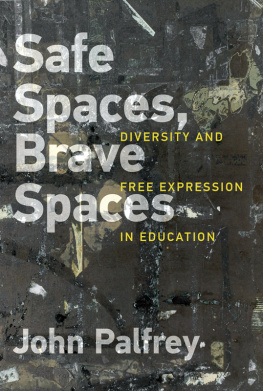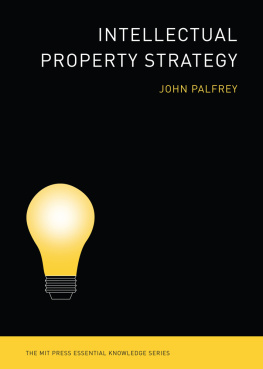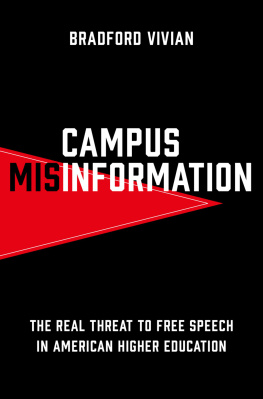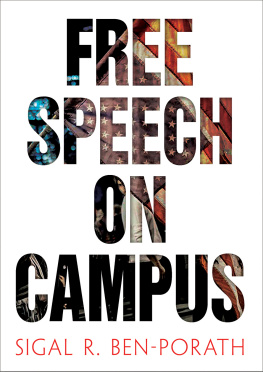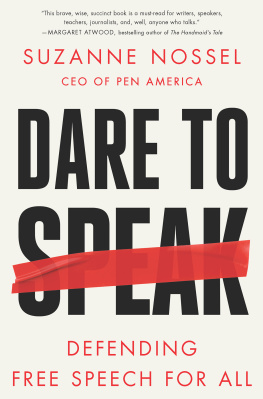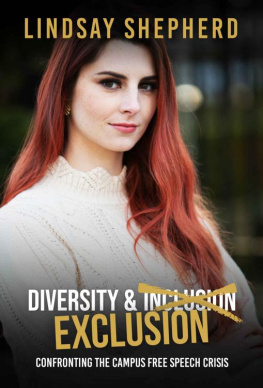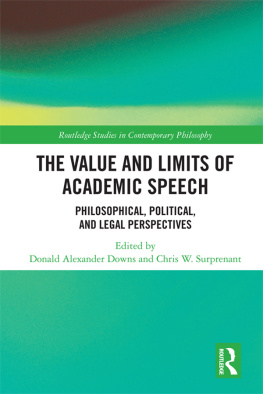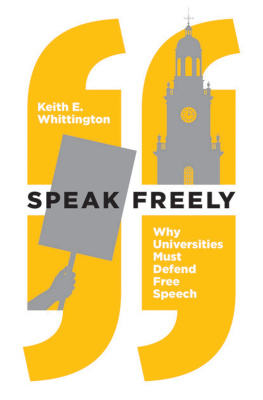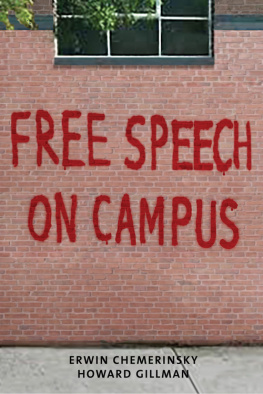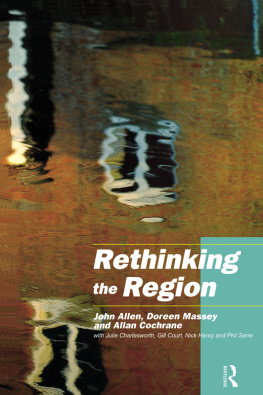
Safe Spaces, Brave Spaces
Diversity and Free Expression in Education
John Palfrey
Foreword by Alberto Ibargen
The MIT Press
Cambridge, Massachusetts
London, England
2017 Massachusetts Institute of Technology
All rights reserved. No part of this book may be reproduced in any form by any electronic or mechanical means (including photocopying, recording, or information storage and retrieval) without permission in writing from the publisher.
This book was set in ITC Stone Serif Std by Toppan Best-set Premedia Limited. Printed and bound in the United States of America.
Library of Congress Cataloging-in-Publication Data
Names: Palfrey, John G. (John Gorham), 1972- author.
Title: Safe spaces, brave spaces : diversity and free expression in education / John Palfrey.
Description: Cambridge, MA : MIT Press, [2017] | Includes bibliographical references and index.
Identifiers: LCCN 2017008607 | ISBN 9780262037143 (hardcover : alk. paper)
eISBN 9780262343657
Subjects: LCSH: Academic freedom--United States. | Freedom of speech--United States. | Multicultural education--United States. | Educational equalization--United States. | Teaching--Social aspects--United States.
Classification: LCC LC72.2 .P35 2017 | DDC 370.1170973--dc23 LC record available at https://lccn.loc.gov/2017008607
ePub Version 1.0
for Sean and Judy Palfrey
exceptional parents and
inspiring educators
Foreword
On March 2, 2017, conservative author Charles Murray gave a speech at Middlebury College. It ended in a near riot.
Student activists argued that Murrays views had no place on campus. As they put it in a letter to the administration: Racism under the guise of academic discourse is still racismand they wanted none of it.
Pundits declared the end of free speech. In the words of one cable news host, On campus, you either have silent appeasement or a bruise. He went on to compare activists to cavemen.
This tribalization of public debate, which weaponizes terms like dialogue and sensitivity, is at the heart of this timely book that should be as useful to school leaders as to editorial writers trying to understand whats happening on campuses.
In his examination of free speech debates on American college campuses, Palfrey asks readers a simple question: Must a community tolerate intolerance in the name of free expression? Its a question I thought my generation had answered. After the upheaval of the Second World War, America in the 1950s saw an unprecedented middle-class revival. With it came an emphasis on convention, tolerance of segregation in much of the country, blacklists, and fear of communism. You couldnt say or do many things on television; on sitcoms, married couples only had twin beds.
Cultural repression provokes creative response. The 1950s brought one of the great periods of dynamic and rebellious literature, painting, and dance in the countrys history. The 1960s followed, with social and political upheaval for racial equality and womens rights and against the war in Vietnamall openly and vehemently protested, freely televised, and extensively reported. As Berkeley activist Mario Savio put it, the only way to stop the operation of the machine was with unfettered speech, wholly consistent with the views of the Founding Fathers who, generations earlier, railed against their machine, called England.
My generations view of free speech was shaped by the Supreme Courts The New York Times v. Sullivan (1964), which held that youre free to write what you believe so long as theres no actual malice. In broad strokes, it reaffirmed the founding principle that more speech is better than less.
You couldnt yell Fire! in a crowded theater and the standard for libel became malice but, short of that, you were pretty much free to express any viewpoint. That fed the pent-up anger over racial and gender injustice that exploded in the 1970s. Television morphing into cable and subscription services allowed speech rules to be relaxed. And then came the Internet, democratizing everything, achieving a kind of free speech Nirvana.
Our evolving understanding of community morphed from a culture of social convention and assimilation to one of respect and admiration for diversity. In time, inclusion became one of Americas core values, worthy not just of encouragement but of protection.
And theres the rub: if a previous generation thought physical safety in a theater or ones reputation in a newspaper were worth protecting, this generation is adding inclusion and diversity to that vaunted level.
Students on campuses today are forcing us to consider that the physical harm that might come from yelling Fire! may be no less damaging than the scourge of racism. Each causes harm: one physical, the other emotional.
In the spirit of the First Amendment, lets hear these students out.
As Palfrey notes, students across the country are grappling with the legacy of the Founding Fathers. The framers declared the equality of mankind but reserved it for white men of means. It took centuries, a civil war, economic changes, constitutional amendments, courage, and tears for the principles to apply to everyone. So, is it any wonder that in the First Amendment, the part of the Constitution that touches all of us daily, many see a tool used for continued exclusion?
We mustnt let that be. We need to find the living, breathing extension of the founding ideal that diversity and free expression make for better democracy.
Students are not trying to abolish the First Amendment. Knight Foundations 2016 Gallup survey of campus attitudes toward free speech found that 78 percent of students believed colleges should expose them to many viewpoints. What is challenging to an older generation is the treatment of diversity and inclusion as a value to be put up against unfettered speech, which led 69 percent of the large sample to favor restricting the use of slurs or language offensive to certain groups, which I interpret as safe spaces.
These values must not be ignored. They arent a fad. It is a young generations response to society and should be understood as an evolving interpretation of free speech rights for the new millennium.
As ever in debate, some remedies may lack coherence or common sense. Should we stop teaching the Western canon because it is Eurocentric? Is an argument against safe spaces truly a form of hate speech? Is pulling a fire alarm a good way to prevent an intolerant speaker from having an audience?
The social psychologist Jonathan Haidt has noted that much of the free speech movement on campuses today has morphed into a quasi-religion. It seeks to stamp out dissenting views as heresy and mobilizes social media rage to shame sinners into silence. This may sound dystopian and exaggerated, but for many professors and students on American college campuses, this ideological tightrope has become an everyday reality.
Palfrey explores both sides of the debatesensitivity and inclusion on one hand, unfettered speech on the otherbut refrains from reductive answers. He is a thoughtful head of school in search of workable solutions that uphold our founding value of free speech, balanced against other societal values, particularly those embraced by a younger generation.
Cool heads will prevail, he reasons, when we push back against factionalism with reasoned compromise and thoughtful debate. When a right-wing author is attacked at Middlebury, or a University of Chicago dean says he doesnt believe in trigger warnings, it feeds the culture of polarization, as does dismissing a generation as snowflakes. We should move away from caricatures that reduce complex social issues into soundbites.
Next page
